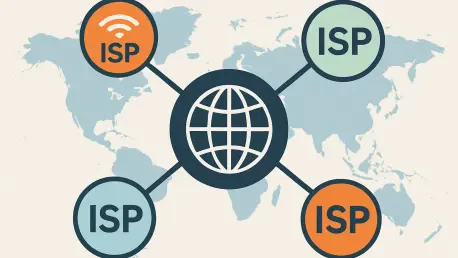In an era where the internet underpins nearly every aspect of daily life—from remote work to streaming entertainment—access to this digital realm is no longer a luxury but a fundamental necessity for millions across the globe, shaping how we live and interact. Internet Service Providers, commonly known as ISPs, serve as the critical link that connects individuals, businesses, and communities to this vast online world. These companies facilitate everything from sending an email to hosting a virtual meeting, using a variety of technologies to ensure seamless interaction with digital content. Far beyond mere gateways, ISPs play a pivotal role in defining the quality and scope of online experiences, influencing how people communicate, learn, and operate in an increasingly connected society. Their impact extends into economic and social spheres, making them indispensable in shaping the modern digital landscape. As technology continues to evolve, understanding the function and influence of ISPs becomes essential for navigating the complexities of connectivity and its broader implications.
The Role and Evolution of ISPs
From Niche to Necessity
The story of ISPs begins in a time when internet access was a rare privilege, confined largely to government entities and academic institutions with specialized resources. It wasn’t until the late 1980s, with the emergence of the World Wide Web, that this exclusivity began to dissolve. Companies like America Online (AOL) pioneered public access through dial-up connections over telephone lines, marking a significant shift toward widespread internet availability. This transformation democratized information, allowing everyday users to explore a burgeoning digital frontier. Over time, ISPs evolved from niche providers to essential utilities, becoming as critical to households as electricity or water. Their role expanded alongside technological advancements, turning a once-elite tool into a cornerstone of global communication and commerce, fundamentally altering societal interactions.
By the mid-1990s, the ISP industry experienced explosive growth, driven by innovations such as broadband through cable and DSL modems, which offered faster and more reliable connections. This period saw thousands of providers enter the market, catering to a rapidly growing user base hungry for digital access. The shift from dial-up to broadband not only improved speed but also enabled new forms of online engagement, from streaming media to real-time collaboration tools. ISPs became the backbone of the internet economy, supporting businesses and individuals in ways previously unimaginable. This rapid expansion highlighted their growing importance, positioning them as key players in economic development and cultural exchange, while also setting the stage for challenges related to access equity and service quality across diverse regions.
The broader impact of ISPs on digital interaction cannot be overstated, as they do more than simply provide a connection—they shape the very nature of online experiences through additional services. Many ISPs bundle internet access with offerings like email accounts, web hosting, and domain registration, creating a more integrated user experience. These extras enhance functionality, allowing users to build websites, manage communications, and store data with ease. Moreover, ISPs influence how content is accessed and prioritized, often acting as gatekeepers to information. Their policies and infrastructure decisions can affect everything from download speeds to the availability of certain platforms, subtly guiding user behavior in the digital space and underscoring their profound role in modern life.
Building the Digital Highway
The structure of the ISP industry reveals a complex hierarchy that significantly impacts service delivery and user access. At the top are Tier 1 ISPs, which own extensive infrastructure, including vast networks of fiber optic cables, and can connect to every part of the internet without paying for transit. These giants often dominate regional markets due to the high costs of building such networks, which can create barriers for smaller competitors. Local ISPs, in contrast, typically lease access from these larger providers, operating on a smaller scale with limited reach. This tiered system influences pricing, service quality, and availability, often leaving consumers in certain areas with fewer choices and higher costs. The disparity between Tier 1 and local providers highlights a critical dynamic in how digital connectivity is distributed and maintained.
Despite the widespread adoption of internet services, accessibility and affordability remain pressing challenges, particularly in underserved communities. Recent data indicates that while a significant majority of American adults use the internet, gaps persist, especially in rural and low-income areas where infrastructure is sparse or outdated. Government initiatives, such as the Affordable Connectivity Program, have stepped in to help bridge this digital divide by subsidizing internet costs for eligible households, including low-income families and seniors. However, these efforts, while impactful, have not fully eliminated disparities, as many still lack reliable access due to geographic or economic constraints. Addressing this issue requires sustained investment in infrastructure and innovative policies to ensure that digital connectivity becomes a universal right rather than a privilege limited by location or income.
Technologies and Services Behind Connectivity
Diverse Delivery Methods
ISPs employ a wide range of technologies to deliver internet access, each tailored to specific user needs and geographic realities, ensuring that connectivity adapts to diverse environments. In urban centers, cable and DSL connections are prevalent, offering relatively high speeds through existing telephone or television infrastructure. Rural areas, however, often rely on older dial-up methods due to limited access to modern networks, resulting in slower and less reliable service. Fiber optic technology, known for its exceptional speed and bandwidth, is increasingly deployed in densely populated regions, though its high installation cost limits widespread adoption. Additionally, satellite internet provides a solution for remote locations where terrestrial options are impractical, though it often comes with higher latency. This spectrum of delivery methods reflects the adaptability of ISPs in meeting varied demands while also exposing the uneven distribution of cutting-edge access across populations.
A common misunderstanding in the realm of connectivity is the conflation of ISPs with WiFi providers, though their functions are distinctly different and complementary. ISPs are responsible for delivering internet access to a location, whether through wired connections like cable or wireless options like satellite, ensuring the raw data pipeline reaches homes or businesses. WiFi providers, on the other hand, focus on distributing that internet within a localized area using routers and modems, enabling devices to connect wirelessly. This distinction is crucial for understanding how connectivity operates at different levels—ISPs lay the foundation by bringing the internet to a doorstep, while WiFi extends that access throughout a space. Clarifying this relationship helps users better navigate their digital setups and troubleshoot issues, as the source of a connectivity problem often lies in distinguishing between these two layers of service provision.
Innovation and Market Trends
The ISP industry is in a state of constant evolution, with major providers pouring resources into infrastructure upgrades to keep pace with escalating demands for faster and more reliable internet. Tier 1 ISPs are particularly active in this space, investing in next-generation technologies like 5G, which promises unprecedented speeds and lower latency for mobile and fixed connections alike. Beyond traditional methods, projects such as SpaceX’s Starlink are redefining possibilities by leveraging low-Earth orbit satellites to deliver broadband to even the most remote corners of the globe. These advancements suggest a future where conventional fiber-based networks might face competition from alternative solutions, potentially leveling the playing field for access in areas long neglected by terrestrial infrastructure. Such innovations signal a transformative shift, challenging established norms and opening new avenues for global connectivity.
Market dynamics within the ISP sector often spark debate due to the concentration of power among a handful of dominant players, a situation rooted in historical and economic factors. The immense cost of building and maintaining internet infrastructure, such as extensive fiber optic networks, creates high barriers to entry, allowing Tier 1 providers to hold significant market shares in many regions. This often resembles monopolistic or oligopolistic behavior, as these companies, many of which inherited infrastructure from past telecom giants, control access and pricing with little competition. Such concentration raises concerns about fairness, as consumers in affected areas may face higher costs or limited service options. The ongoing discussion around market competition underscores the need for regulatory oversight and innovative entrants to ensure that digital access remains equitable and affordable for all, rather than being dictated solely by a few powerful entities.
Reflecting on Digital Foundations
Looking back, the journey of ISPs reveals a remarkable transformation from exclusive tools of the few to vital connectors for the many, reshaping how society functions over decades. Their evolution mirrors technological leaps, with each advancement—be it broadband or satellite solutions—addressing past limitations and expanding reach. Challenges like market concentration and access disparities persist, often reflecting deeper systemic issues that demand collaborative solutions. The role of ISPs in bridging digital divides becomes evident, as does the complexity of balancing innovation with equity. Moving forward, stakeholders must prioritize sustainable infrastructure investments and policies that support underserved communities. Exploring partnerships between public and private sectors could accelerate progress, while embracing emerging technologies might redefine access norms. These steps, grounded in lessons from history, offer a path to a more inclusive digital future where connectivity empowers every corner of society.









